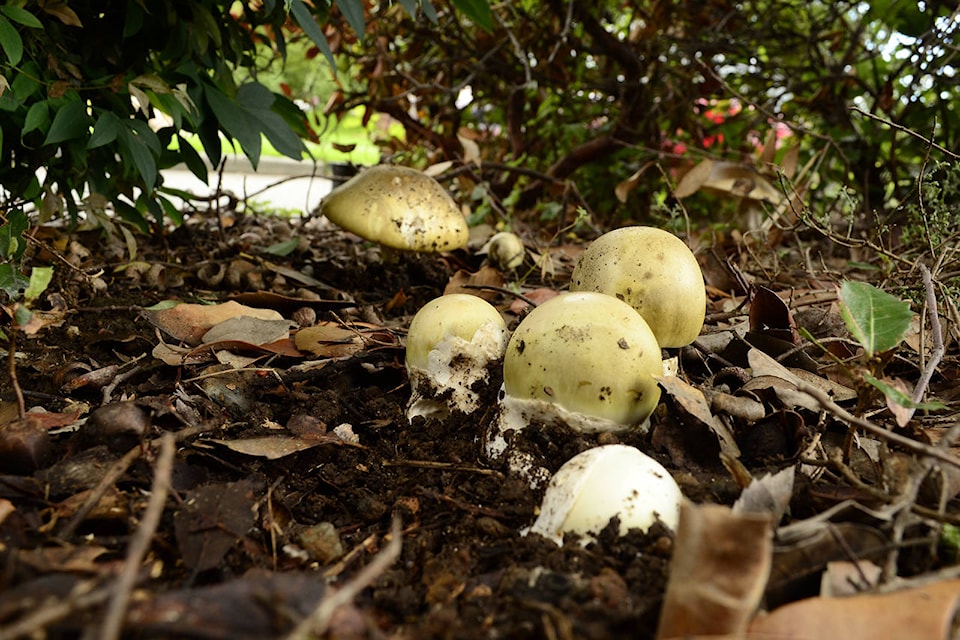What’s growing in your front yard? According to some Agassiz residents, it could be the death cap mushroom.
In at least one Facebook post, residents said they had seen a number of lawns with the deadly fungus. Debates flared over whether the mushrooms were truly poisonous or not, with many being unable to positively identify the death caps.
According to UFV biologist and science communicator Carin Bondar, that’s not surprising.
“I think it might be the most toxic mushroom to humans out there, and to have these things growing is a little bit scary, especially since they look a lot like the puffballs,” Bondar said.
The death cap mushrooms are often yellow or green in tint, although they can be completely white, and have white gills underneath the top of the cap. There is a white “skirt” on the stem near the cap, and a loose, sac-like cup that is often below ground. The juvenile form of the mushrooms look like the harmless puffball mushroom — which is edible — and the older form can look like the imported Asian paddy-straw mushroom.
Right now is the main fruiting season for mushrooms of all types, since the wetness in the soil makes for a perfect growing environment. The death caps are expected to finish up their time above ground by mid-November, although depending on the temperature, it could go into late November or December.
Death cap mushrooms, also known by their scientific name Amanita phalloides, are not native to North America. The fungus is widely distributed across Europe, and has a beneficial relationship with hardwood trees in those areas.
However, the mushroom can also appear in other areas, by hitchhiking in the soil of imported plants like oaks, birch and chestnut trees.
RELATED: World’s most poisonous mushroom spreading in B.C.
“We kind of have this great big question mark of where these things are going to pop up, because it depends on where certain trees that have been brought over were planted,” she said. “It’s totally possible, and likely probable, that there would be some pockets of death cap around because they have been introduced with specific trees.”
Although they are not native to British Columbia — the first fungus was found in the province in 1997 — death cap mushrooms are still extremely dangerous.
The fungus contains neurotoxins that can damage the liver and kidney. An initial bout of cramping, diarrhea and vomiting will begin within six and 12 hours after the mushroom is eaten, then taper off only to come back with a vengeance several days later, accompanied by seizures, kidney failure, liver failure and jaundice, among other symptoms.
The time from initial symptoms to death is between seven and 10 days; anyone who thinks they have eaten a death cap mushroom should go to the hospital and call poison control immediately (1-800-567-8911).
RELATED: Disease control warns mushroom pickers against death cap
According to Bondar, just touching a death cap isn’t enough to cause a problem — only eating it is. And the best way to help get rid of death caps in your yard is to deal with the fruiting bodies of the fungus as they pop up.
“The bulk of a fungal network exists underground, so the fibres are all over and the mushrooms are attached together underneath the ground. So there’s a huge network underground, and a little tiny bit of fruiting bodies above ground,” Bondar explained. “So if you just pick up the fruits, there going to just keep popping up.
“That’s okay, as long as you are more vigilant about it, eventually they’ll just fruit someplace else.”
Handle the mushrooms with gloves, just in case, and dispose of them either in municipal compost bins or garbage cans. Home compost may not reach a high enough temperature to keep the mushrooms from continuing to grow in the compost bin.
Other methods of control include not over-watering lawns, which can be difficult when nature keeps B.C.’s yards moist.
“The fungus are there, and because they form such a massive underground network, there’s really no way we can rid ourselves of them,” Bondar said. “Understanding that they’re toxic and behaving accordingly is our best bet moving forward.”
grace.kennedy@ahobserver.com
Like us on Facebook and follow us on Twitter
